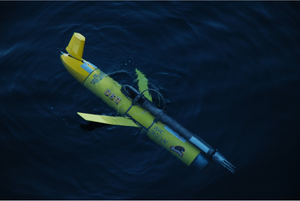
College of Engineering Unit:
The purpose of this project was to create a system to allow the Slocum G3 Glider to detect wave conditions while on the ocean surface, and to make it available to the communications modules inside the glider so that it can be sent back to shore.The measurements our system was designed to measure include up to 13 different characteristics of waves including swell height, period, and direction. This was accomplished using a low power microcontroller, SD card, and accelerometer on a PCB mounted in the glider’s science bay. As the glider has one primary battery as the main energy source, our system must be able to calculate the desired data all while consuming a minimal amount of power to minimize possible impacts on the glider’s battery life.
The Slocum Glider is a type of Autonomous Underwater Vehicle (AUV) designed to monitor underwater conditions such as ocean salinity, temperature, depth, etc. It operates by using ballast tanks and short wings on its sides to propel itself through the water. While in operation it dives and resurfaces, and that process causes water to move over its wings, propelling it forwards. After a predetermined number of glide cycles, the glider resurfaces to transmit the collected data back to shore for analysis. The end-user group that this project is focused on is the College of Earth, Ocean, and Atmospheric Sciences here at Oregon State University which uses these gliders around the world for a number of research projects.
The implementation of this project uses an STM32 microcontroller connected to an accelerometer. The microcontroller gathers data from the accelerometer and stores it in an SD card, as well as performing the fourier transform on the data to send it to the main computer onboard the glider. The glider provides the board with a 17V power supply. A buck regulator is used on our board to convert the 17V down to 3.3V.
This project will be used by researchers and deployed on a specialized vehicle. Our end user is someone who works in a research facility and already has some Slocum gliders laying around but has no way to use them to measure waves. With our project, they can retrofit their glider with an accelerometer board and be well on their way to capturing wave data. Because this project will be installed on the inside of a glider, it can be delivered as a bare printed-circuit board. We can assume that the end user will have a technical background, and can safely handle the device to prevent damage due to electrostatic discharge, and that we will not be responsible for preventing damage due to water or particle ingress. Ocean gliders are expensive to operate, and are typically deployed for up to three months, so it is important to the stakeholders that the system operates reliably during that period.
The end user will receive the completed system and access to the project wiki. The user will then install the system in a SLOCUM G3 ocean glider. When the glider is deployed in the ocean, the user will command the glider to surface several times per day. When it is at the surface, the glider’s computer will power the system on and float at the surface for 20 minutes while the system collects and processes wave data. When the system has completed a data collection cycle, it will transmit the calculated wave parameters to the glider’s computer and indicate that it has completed the data analysis. The glider can then send the wave parameters to shore wirelessly. Once the glider has completed its deployment, it is retrieved from the ocean, and can be opened to retrieve the system’s SD card which contains all raw data that was collected. The user can then take this data and perform a more thorough analysis.
Project Website(s):
Industry Sponsor(s):
Project Communication Piece(s):
| Attachment | Size |
|---|---|
| 9.6 MB | |
| 923.23 KB |